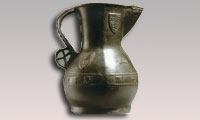
Luton is a town and borough in Bedfordshire, England. The borough had a population of 225,262 at the 2021 census.

Bedfordshire is a ceremonial county in the East of England. It is bordered by Northamptonshire to the north, Cambridgeshire to the north-east, Hertfordshire to the south and the south-east, and Buckinghamshire to the west. The largest settlement is Luton (225,262), and Bedford is the county town.

Ian Hamilton Finlay was a Scottish poet, writer, artist and gardener.

Luton South and South Bedfordshire is a constituency in Bedfordshire represented in the House of Commons of the UK Parliament since 2019 by Rachel Hopkins, a member of the Labour Party.

Farley Hill is a suburb of south Luton, Bedfordshire, England. The area is roughly bounded by the Dallow Downs to the north and north-east, Stockwood Park to the south, the M1 motorway to the west, and Wilsden Avenue and Bolingbroke Road to the east.

Houghton Regis is a market town and civil parish in the Central Bedfordshire district of Bedfordshire, England.

Wardown Park is situated on the River Lea in Luton. The park has various sporting facilities, is home to the Wardown Park Museum and contains formal gardens. The park is located between Old Bedford Road and the A6, New Bedford Road and is within walking distance of the town centre. It is Grade II listed in Historic England's Register of Parks and Gardens.

The Mossman Carriage Collection is a museum housing a collection of horse-drawn vehicles in Stockwood Park, Luton, Bedfordshire. It is the largest collection of such vehicles in the United Kingdom, and includes original vehicles dating from the 18th, 19th and 20th centuries.

Wardown House Museum and Gallery, formerly Wardown Park Museum and, before that, the Luton Museum & Art Gallery, in Luton, is housed in a large Victorian mansion in Wardown Park on the outskirts of the town centre. The museum collection focuses on the traditional crafts of Bedfordshire, notably lace-making and hat-making. There are samples of Bedfordshire lace from as early as the 17th century.

Stockwood Park is a large urban park in Luton, Bedfordshire, in the Farley Hill estate. With period formal gardens, leading crafts museums, Stockwood Park Rugby Club and extensive golfing facilities, it is about 100 hectares in area.

Luton International Carnival is a large carnival in Luton, Bedfordshire. The carnival is commissioned by Luton Borough Council and is artistically produced by UK Centre for Carnival Arts, which is based in Luton town centre.

Luton is a town located in the south of Bedfordshire, England.

Dunstable is a market town and civil parish in Bedfordshire, England, east of the Chiltern Hills, 30 miles north of London. There are several steep chalk escarpments, most noticeable when approaching Dunstable from the north. Dunstable is the fourth largest town in Bedfordshire and along with Houghton Regis forms the westernmost part of the Luton/Dunstable urban area.

The Higgins Art Gallery & Museum is the principal art gallery and museum in Bedford, Bedfordshire, England, run by Bedford Borough Council and the trustees of the Cecil Higgins Collection.
Eileen Hogan is a figurative painter, who lives and works in London. She has shown in museums and private galleries in the UK and America. Her retrospective exhibition at the Yale Center for British Art in New Haven, USA in 2019, accompanied by a book published by Yale University Press, focused particularly on two dominant themes – enclosed gardens and portraiture. She is a professor emeritus at the University of the Arts London, a trustee of the Royal Drawing School, and an ambassador for the Salveson Mindroom Centre, a Scottish charity.

Luton Corporation Tramways served the town of Luton in Bedfordshire from 21 February 1908 until 16 April 1932.

High Town is an inner area of Luton immediately north of Luton railway station, and a ward of the Borough of Luton, in the ceremonial county of Bedfordshire, England.

The Wenlok jug or Wenlock jug is a rare surviving example of an English bronze jug from the 15th century, with great significance for the study of bronze working in medieval England. Only two similar jugs are known in the UK. The Wenlok jug is the smallest of the three, but bears the earliest maker's mark for the English founder - possibly a bell founder - who cast it. The other examples are the Asante Ewer, which retains its lid and is held by the British Museum having been found at Kumasi in the Gold Coast in 1896 during the Anglo-Ashanti wars, and the Robinson jug, which was found in a farmhouse in Norfolk in the 1879 and is now in the collection of the Victoria & Albert Museum. All bear inscriptions in English and were made from leaded bronze, an alloy of copper, tin and lead, cast in a two-part mould in a similar manner using bronze spacers to separate the inner and outer moulds, with similar decorative motifs.
Thomas Wyatt Bagshawe was an explorer, museum curator and folklorist.




















